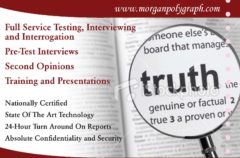
How Polygraph Technology Has Evolved to Improve Accuracy
Welcome to our deep dive into the fascinating world of polygraph technology! Whether you’re a criminal justice enthusiast or just curious about how lie detectors have changed over the years, this post is for you. Let’s unravel the evolution of this technology and how it has become more accurate over time. 📈
Table of Contents
1. Introduction: The Birth of the Polygraph
2. The Science Behind Polygraphs
3. Major Advances in Polygraph Technology
4. Modern-Day Polygraph Applications
5. Conclusion: The Future of Lie Detection
6. FAQ
Introduction: The Birth of the Polygraph
The polygraph, often referred to as a “lie detector,” has a rather intriguing history. It all started in the early 20th century with the invention of the first device aimed at measuring physiological responses to questions. Leonard Keeler is credited with the development of the modern polygraph in the 1930s, but the journey didn’t stop there. Let’s explore how this technology has matured over the decades.
The Science Behind Polygraphs
At its core, a polygraph measures physiological indicators such as blood pressure, pulse, respiration, and skin conductivity. The underlying theory is that these indicators change when a person is being deceptive. While the science is debated, the technology has continuously evolved to improve the reliability of these measurements.
Major Advances in Polygraph Technology
🚀 **Computerization:** The introduction of computer algorithms in polygraph analysis has been a game-changer. Computers help in more accurately interpreting the physiological data collected during tests, reducing human error.
🧠 **Neuroscience Insights:** Recent research in neuroscience has improved our understanding of how the brain behaves during deception, leading to better question techniques and analysis methods.
📱 **Portable Devices:** Recent advancements have made polygraphs more portable and accessible, allowing for testing in various environments, which can lead to more accurate results.
Modern-Day Polygraph Applications
Today, polygraphs aren’t just for criminal investigations. They are used in various fields such as employment screening, security clearances, and even in reality TV shows! This broad application is a testament to how much the technology has improved in terms of accuracy and reliability.
Conclusion: The Future of Lie Detection
As technology continues to evolve, the future of polygraph testing looks promising. With ongoing research and technological advancements, we can expect even more accurate and reliable methods of lie detection. Who knows, maybe one day we’ll have a device that can read minds! 🤔
FAQ
Q: Are polygraphs 100% accurate?
A: No, while technology has improved their accuracy, polygraphs are not foolproof and are subject to interpretation and contextual factors.
Q: Can anyone take a polygraph test?
A: Generally, yes, but it’s important for the test to be administered by a qualified professional to ensure valid results.
Q: How long does a typical polygraph test take?
A: A standard polygraph test can take anywhere from 1 to 3 hours, depending on the complexity of the questions and the depth of the investigation.
Q: Is it possible to “beat” a polygraph test?
A: While some claim it’s possible to manipulate results, doing so is difficult and risky. The most reliable approach is always honesty.
Thank you for joining us on this exploration of polygraph technology! If you have any more questions or thoughts, feel free to share them in the comments. 😊
